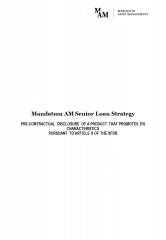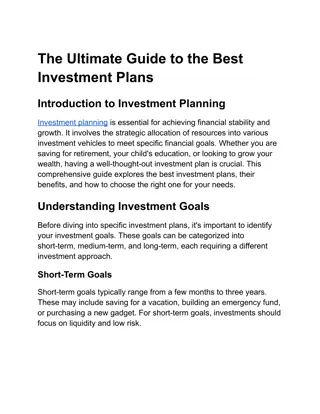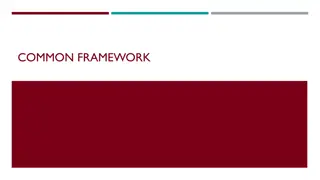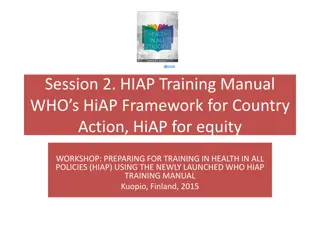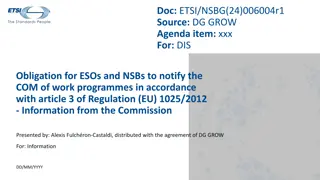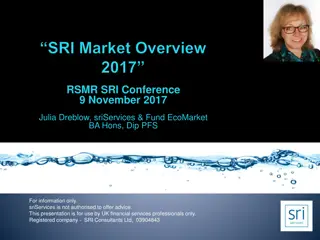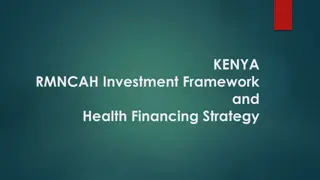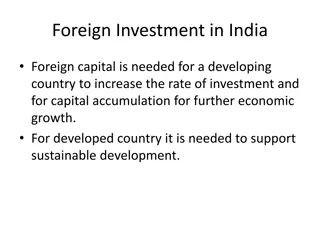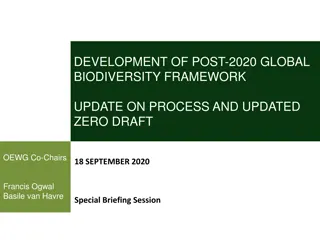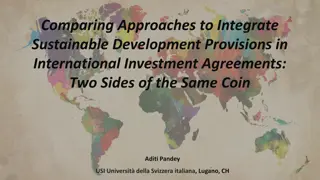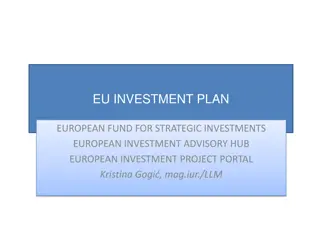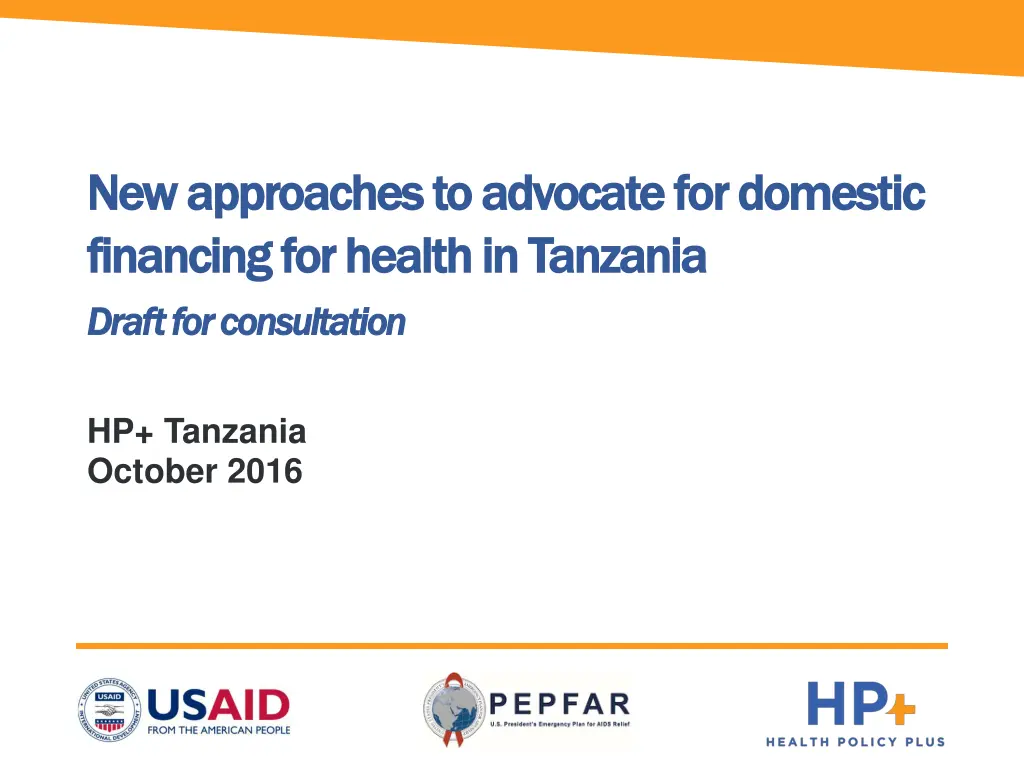
New Approaches to Advocate for Domestic Financing for Health in Tanzania
Explore new approaches to advocate for domestic financing for health in Tanzania by reflecting on international spending targets, understanding the importance of increasing public spending, and proposing specific strategies tailored to the Tanzanian context. Assess the impact of international spending targets and the challenges faced in allocating sufficient funds for universal primary health care services.
Download Presentation

Please find below an Image/Link to download the presentation.
The content on the website is provided AS IS for your information and personal use only. It may not be sold, licensed, or shared on other websites without obtaining consent from the author. If you encounter any issues during the download, it is possible that the publisher has removed the file from their server.
You are allowed to download the files provided on this website for personal or commercial use, subject to the condition that they are used lawfully. All files are the property of their respective owners.
The content on the website is provided AS IS for your information and personal use only. It may not be sold, licensed, or shared on other websites without obtaining consent from the author.
E N D
Presentation Transcript
New approaches to advocate for domestic New approaches to advocate for domestic financing for health in Tanzania financing for health in Tanzania Draft for consultation Draft for consultation HP+ Tanzania October 2016
Draft for consultation Objectives Explore the context of international spending targets Reflect on the impact they ve had in Tanzania Understand why increasing public spending is important Propose potential new approaches specific to the Tanzanian context that could be more effective 2
Draft for consultation Several international spending targets have been proposed 2001 2001 2009 2009 2014 2014 Abuja Abuja Declaration Declaration Chatham Chatham House House Source Source WHO WHO Amount of public spending on health as a % of GDP - captures both the priority given to health in budget allocations, and the fiscal context 5% of GDP may be insufficient for many LICs to fund universal PHC services, which is estimated to require at least $86 per capita (in 2012 USD) We pledge to set a target of allocating at least 15% of our annual budget to the improvement of the health sector Description Description GGHE = $86 per GGHE = $86 per capita, GGHE = 5% of GDP GGHE = 5% of GDP (whichever is greater) (whichever is greater) capita, or or Measure Measure GGHE = 15% of GGE GGHE = 15% of GGE GGHE = 5% of GDP GGHE = 5% of GDP GGHE: General government health expenditure GGE: General government expenditure GDP: Gross domestic product LICs: low income countries PHC: Primary health care 4
Draft for consultation Spending targets appear to have limited impact on health budgets Domestic health budget as a % of total govt. budget1 and as a % of GDP2 16 Abuja target = 15% 14 12.3 11.6 11.6 11.3 11.3 11.1 12 10.4 10.3 10.2 10 9.5 10 10.5 10.5 10.3 10 9.7 9.4 9.4 9.3 8 8.9 8.1 6 GDP target = 5% 7.0 4 2.0 2.0 1.9 1.8 1.7 1.6 2 0 2006/07 2007/08 2008/09 2009/10 2010/11 2011/12 2012/13 2013/14 2014/15 2015/16 2016/17 GGHE as % of GGE (in-country sources, excl. CFS) GGHE as % of GDP (in-country sources) GGHE as % of GGE (in-country sources, incl. CFS) 1 Ministry of Finance and Planning, Tanzania. 2007/08-2016/17 Budget Volumes (as passed by National Assembly). 2 International Monetary Fund, World Economic Outlook Database, April 2016 and HP+ analysis CFS - Consolidated funds services, GGHE General government health expenditure, GGE General government expenditure 5
Draft for consultation Resource gap is only projected to increase under HSSP IV HSSP IV resource gap range, 2016-2020 1,400 1,200 $1,172 $1,001 1,000 2014 USD Millions $836 $832 800 $660 $661 $737 $680 600 $489 $534 $422 400 $350 $259 200 0 2015/16 2016/17 2017/18 2018/19 2019/20 Tanzania may face challenges in scaling up health programs and strengthening its health system given these funding gaps advocating for greater public spending on health will advocating for greater public spending on health will become increasingly critical become increasingly critical 1 Barker, C., Dutta, A., Sustainability Implications for Tanzania s Fourth Health Sector Strategic Plan, 2015/16 2019/20, Health Policy Project, Sept 2015 6
Draft for consultation Increased public spending leads to improved financial protection Catastrophic health expenditure among poorest and richest quintiles1 % of quintile facing catastrophic 14 12 10 8 6 4 2 0 health expenditure Mali 2001 Niger 2011 Kenya 2003 Rwanda 2010 Zambia 2006 Ghana 2006 Malawi 2004 Senegal 2011 Uganda 2002 Tanzania 2010 Cabo Verde 2001 Poorest 20% Richest 20% Cross-country evidence suggests that as UHC performance initially service coverage coverage2 as public spending increases public spending increases, there is convergence in service coverage coverage improves and eventually so does financial financial 1 Public Financing for Health in Africa: from Abuja to the SDGs, WHO, 2016 2Jowett et. al., Spending targets for health: no magic number, WHO, 2016 7
New approaches Draft for consultation
Draft for consultation Two main periods to advocate for greater public spending on health Parliamentary debate and approval Reporting and stakeholder consultations Planning and budget formulation Budget submission and review MOF MOF consultative consultative meetings meetings with revenue generating MDAs and Agencies, and key strategic Ministries Submission of budget performance reports by MDAs, RSs, LGAs National Budget Speech presented and debated; Budget voted Budget voted into Law into Law Submission of Submission of plan plan and budget proposals to MOF Parliamentary sub-committee review MTEF; Budget entry into IFMIS July - August November - January February March - April May June September - October Submission of Submission of final budget final budget estimates to Cabinet; Production of Budget Book Joint review of Joint review of plans and plans and budgets budgets by MOF, PO-PC, MDAs, RSs, LGAs Key advocacy window Key advocacy window Preparation of plans and budgets by MDAs, RSs, LGAs Annual sector consultative consultative reviews reviews Key advocacy window Key advocacy window Execution of Plan and Budget / Ongoing Monitoring and Evaluation 9
Draft for consultation New approaches and suggested criteria for assessment Four approaches Four approaches 1 1 2 2 Prioritization of Prioritization of a annual needs (based on the current approach) (based on the current approach) nnual needs Focus on health sector targets Focus on health sector targets 3 3 4 4 Meeting middle income commitments Meeting middle income commitments Health as an investment Health as an investment Criteria for assessment Criteria for assessment Is the absolute and relative value of funding unlocked by this approach potentially significant? Potential gain Potential gain Does the approach require customization each year, or consistent multi-year advocacy? How complex is the approach and how much coordination is needed? Timeline / effort Timeline / effort Does the approach communicate in terms that resonate with MOFP? Does the approach link health spending to development more broadly? Appeal to MOFP Appeal to MOFP 10
Draft for consultation 1 1 Prioritization of annual needs Key characteristics Key characteristics Input based Input based Operational Operational Short term focus Short term focus Assessment against criteria Assessment against criteria Limited to specific asks that represent immediate needs, line item based and not linked to strategic goals Potential gain Potential gain Timeline / Effort Timeline / Effort Annual process, requires extensive donor/MOHCGDEC coordination and sustained effort Appeal to MOFP Appeal to MOFP Limited, doesn t highlight efficiencies, health outcomes or links to broader development goals Methods Methods Pros and Cons Pros and Cons Development partners and civil society; Allows for customized approach each year Opportunistic Promotes communication between partners Most aligned with MOH current methods and budgeting cycle individually prioritize their key budget concerns for the coming budget cycle meet to discuss their budget concerns and prioritize 2-4 budget asks Wins are likely to be incremental rather than systematic Not rooted in any specific framework Line item based; not linked to outcomes Analyses and advocacy briefs prepared to support budget asks. Focused advocacy to GOT conducted for the priority budget asks 11
Draft for consultation 1 1 Prioritization of annual needs Illustration of Illustration of Impact Impact Improvements to this approach Improvements to this approach For FY 16/17, new allocation of TZS 251.5 MOHCDGEC development vote, and a substantial portion was used to pay down MSD debt However while the total health budget increased nominally it actually decreased proportionally relative to the prior year TZS 251.5 billion billion in the Further disaggregation of MOH budget lines (e.g. salaries) may reveal arguments for investment due to shortages in specific cadres or regions Further disaggregation of development budget can be used to increase budgets based on relative productivity and need; LGA level dashboards can be developed to illustrate this 350 300 Nominal TZS Billions 250 200 New 251.5 150 100 LGA Dashboard LGA Dashboard 50 61.6 49.6 0 FY 2015/16 FY 2016/17 FY 2016/17: TZS 251.5 billion Specialized Institutes 9% MSD DEBT 34% Health Facilities 24% Clearing and Forwarding of Medical supplies and Services 14% Source: Lee, B., Dutta, A., et. al., Budget Analysis of the Government of Tanzania s Ministry of Health, Community Development, Gender, Elderly and Children Fiscal Year 2016/17 12
Draft for consultation 2 2 Focus on health sector targets Key characteristics Key characteristics Outcome based Outcome based Strategic Strategic Long ter Long term m focus focus Assessment against criteria Assessment against criteria Significant, both for specific health areas (e.g. MCH) and for health systems goals (e.g. HRH and infrastructure investment) Significant upfront effort to prioritize intermediate outcomes and monitoring system, then an annual progress check and update Limited, focused on national and international health targets and outcomes without linking to MOFP priorities Potential gain Potential gain Timeline / Effort Timeline / Effort Appeal to MOFP Appeal to MOFP Methods Methods Pros and Cons Pros and Cons Link international health targets to national commitments (e.g. SDGs to Vision 2025) Tangible progress can be measured against well established targets Promotes MOHCGDEC accountability for health outcomes Allows for consistent multi-year advocacy Relevant to the international community and external funding Isolate intermediate outcomes that lead to topline indicators (e.g. 4+ ANC visits and SBA for MMR) Develop dashboards to track progress against intermediate and final outcomes Targets may not be fully owned by all stakeholders Time lag in data collection, processing and availability Prioritize outcomes with lagging progress for budget advocacy work with GoT 13
Draft for consultation 2 2 Focus on health sector targets Illustration of Illustration of Impact Impact Implementing this approach Implementing this approach An evaluation of the pay for performance (P4P) scheme in Rwanda revealed the greatest effect on those services that had the highest payment rates and needed the least effort from the service provider.1 P4P incentives P4P incentives can improve both the use and quality of of MCH services MCH services, and could serve to accelerate progress towards achievement of MCH targets achievement of MCH targets. Advocate for program based program based budgeting to allow for greater visibility on spending and stronger links to impact and health outcomes budgeting implementation use and quality Workshops to determine key intermediate actions/outputs actions/outputs necessary to improve high level outcomes (e.g., BRN Workshop identified key initiatives and enablers to improve RMNCH) key intermediate U5 U5 mortality mortality2 2 Tracking annual progress annual progress facilitated through dashboards for consistency and ease Prioritized advocacy to GOT to fund key intermediate actions that will facilities progress against stated health sector targets Maternal Maternal mortality mortality2 2 1Effect on maternal and child health services in Rwanda of payment to primary health-care providers for performance: an impact evaluation, Basinga, Paulin et al. The Lancet , Volume 377 , Issue 9775 , 1421 - 1428 2Countdown to 2015 Fulfilling the Health Agenda for Women and Children The 2014 Report 14
Draft for consultation Meeting middle income commitments 3 3 Key characteristics Key characteristics Statutory Statutory Externally driven Externally driven Phased Phased Assessment against criteria Assessment against criteria Significant; public funding must be mobilized to meet higher co-financing needs (though there could be limited impact on the total health budget given potential displacement effect) Potential gain Potential gain Timeline / Effort Timeline / Effort Multi year transition process, requires sustained effort Significant; Linked to broader economic progress and national developmental vision as well as statutory requirements Appeal to MOFP Appeal to MOFP Methods Methods Pros and Cons Pros and Cons Work with MOFP on macro-fiscal projections of TZ s transition to lower middle income status and beyond Needs can be well defined and time bound according to a transition strategy Promotes consistent multi-year advocacy Driven by multiple donors (GFATM, PEPFAR, GAVI etc.) and is a mandatory requirement of continued funding Linked to a positive achievement (i.e. reaching a higher income status) Model the funding implications of this change including transition timelines and projected changes in funding need Prioritize budget advocacy to GoT on the basis of these expected transitions and projected funding shortfalls for specific health interventions Does not necessarily mobilize any new money Focused mostly on vertical programming (e.g. would not benefit SNHI pooling and sustainability) May not be priorities for all stakeholders Not linked to structural reforms 15
Draft for consultation Meeting middle income commitments 3 3 Implementing this approach Implementing this approach Examine scenarios of how and when Tanzania reaches middle income status - development of a phased implementation plan to achieve various policy, budgetary and operational targets will be required Multi-partner external assessments Areas: Program performance Institutional capacity Financial sustainability Alignment with HSS priorities Actions with assigned responsible parties and timelines Costed activities, and technical assistance needs identified Holistic plan that takes into account all external funding support Transition Transition Plans Plans Transition Transition Assessment Assessment Recurrent report of plan implementation Joint appraisal of strategies and their implementation Post-transition appraisal of transition process and future needs Implemen Implemen- - tation tation of Plans Plans Monitoring Monitoring Framework Framework of Support to be provided through: Technical Assistance Implementing partners Comprehensive engagement approach to transition Comprehensive engagement approach to transition1 1 Explore intermediate financing mechanisms (including loans and guarantees) to bridge the funding gap in the short term; develop longer term financing strategies to increase the sustainable domestic funding of the health sector 16 1Graphic adapted from GAVI WHO Consultation Orientation, Slide 25, June 2016
Draft for consultation 4 4 Health as an investment Key characteristics Key characteristics Economic Economic Multi Multi- -sectoral sectoral Relative performance Relative performance Assessment against criteria Assessment against criteria Significant; health is currently underfunded relative to other social sectors and the empirical evidence that health is an investment is compelling Annual process due to fluctuations in state of the economy (and consequently government revenues) and competing MOFP priorities Significant; Prioritizes demonstrating impact on other sectors and the economy Potential gain Potential gain Timeline / Effort Timeline / Effort Appeal to MOFP Appeal to MOFP Methods Methods Pros and Cons Pros and Cons Build investment cases for health interventions showing multi-sectoral benefits, for example, link; Highlights health s relative contribution to GDP and other sectors reframes as an investment not an expense Links specific interventions or health areas to broader developmental outcomes Conveys advocacy in MOFP language (e.g. impact on GDP per capita, return on investment) Provides a new rationale for increasing investment on highly effective health interventions Improved nutrition/child health to better education attainment HRH investments to economic growth Improved access to increased labor productivity Highlight where health sector budget execution and service delivery capabilities outperform relative to other sectors Theoretical and limited evidence base (beyond concepts) Could be politically sensitive if it portrays other sectors negatively Requires significant analytical capacity and financial fluency among stakeholders and the MOH Prioritize budget advocacy to GoT on the basis of economic returns and multi-sectoral benefits 17
Draft for consultation 4 4 Health as an investment Implementing this approach Implementing this approach Develop investment cases modeled on examples from other countries (e.g. RMNCH investment case) Summarize findings from the literature on returns on investments in health and tailor to local context Present the Tanzania specific analyses developed to the MOFP illustrating how MOHCGDEC has capacity to achieve them How better health contributes to higher GDP per capital How better health contributes to higher GDP per capital1 1 18 21The Lancet, Global Health 2035, Policy Brief #2, The returns to investing in health, December 2013
Draft for consultation Summary of approaches Potential gain Potential gain Timeline/ Effort Timeline/ Effort Appeal to MOFP Appeal to MOFP Priority Priority Prioritization of annual needs Annual, continuous Limited Limited TBD TBD Research questions Focus on health sector targets Multi-year, front loaded effort Significant Limited TBD TBD Meeting middle income commitments Multi-year, continuous Significant Significant TBD TBD Health as an investment Annual, continuous Significant Significant TBD TBD 19
Draft for consultation Next steps Discuss potential new approaches during round table discussion Summarize initial reactions, questions and feedback from discussions Determine which approach(es) should be; Tweaked Eliminated Prioritized Added Refine analysis on subset of approaches 20
http://healthpolicyplus.com policyinfo@thepalladiumgroup.com @HlthPolicyPlus HealthPolicyPlusProject Health Policy Plus (HP+) is a five-year cooperative agreement funded by the U.S. Agency for International Development under Agreement No. AID- OAA-A-15-00051, beginning August 28, 2015. The project's HIV-related activities are supported by the U.S. President's Emergency Plan for AIDS Relief (PEPFAR). HP+ is implemented by Palladium, in collaboration with Avenir Health, Futures Group Global Outreach, Plan International USA, Population Reference Bureau, RTI International, the White Ribbon Alliance for Safe Motherhood (WRA), and ThinkWell. The information provided in this document is not official U.S. Government information and does not necessarily represent the views or positions of the U.S. Agency for International Development.

